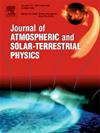Evaluating water use efficiency and CO₂ absorption in plants under rising atmospheric carbon dioxide levels
IF 1.8
4区 地球科学
Q3 GEOCHEMISTRY & GEOPHYSICS
Journal of Atmospheric and Solar-Terrestrial Physics
Pub Date : 2025-01-01
DOI:10.1016/j.jastp.2024.106409
引用次数: 0
Abstract
While elevated CO₂ levels have been shown to initially enhance photosynthesis, the long-term global effects on photosynthesis rates are influenced by a complex set of interacting factors. Although theoretical thresholds exist where further increases in CO₂ could potentially reduce photosynthesis, current research suggests that these levels remain far off. Contrary to recent reports suggesting a decline in water use efficiency (WUE) in plants, a review of the latest literature indicates that plants are, in fact, using water more efficiently while continuing to absorb atmospheric CO₂. This analysis highlights that rising CO₂ concentrations are contributing to improved WUE in plants, reflecting an adaptive response rather than a decline in functionality.
在大气二氧化碳水平上升的情况下评估植物的水利用效率和CO 2吸收
虽然二氧化碳水平升高已被证明最初会增强光合作用,但对光合作用速率的长期全球影响受到一系列复杂相互作用因素的影响。虽然理论上存在二氧化碳浓度进一步增加可能会减少光合作用的阈值,但目前的研究表明,这些阈值还很遥远。与最近有关植物水分利用效率(WUE)下降的报道相反,对最新文献的回顾表明,事实上,植物在继续吸收大气中的二氧化碳的同时,也在更有效地利用水分。该分析强调,二氧化碳浓度的上升有助于提高植物的用水效率,这反映了一种适应性反应,而不是功能的下降。
本文章由计算机程序翻译,如有差异,请以英文原文为准。
求助全文
约1分钟内获得全文
求助全文
来源期刊

Journal of Atmospheric and Solar-Terrestrial Physics
地学-地球化学与地球物理
CiteScore
4.10
自引率
5.30%
发文量
95
审稿时长
6 months
期刊介绍:
The Journal of Atmospheric and Solar-Terrestrial Physics (JASTP) is an international journal concerned with the inter-disciplinary science of the Earth''s atmospheric and space environment, especially the highly varied and highly variable physical phenomena that occur in this natural laboratory and the processes that couple them.
The journal covers the physical processes operating in the troposphere, stratosphere, mesosphere, thermosphere, ionosphere, magnetosphere, the Sun, interplanetary medium, and heliosphere. Phenomena occurring in other "spheres", solar influences on climate, and supporting laboratory measurements are also considered. The journal deals especially with the coupling between the different regions.
Solar flares, coronal mass ejections, and other energetic events on the Sun create interesting and important perturbations in the near-Earth space environment. The physics of such "space weather" is central to the Journal of Atmospheric and Solar-Terrestrial Physics and the journal welcomes papers that lead in the direction of a predictive understanding of the coupled system. Regarding the upper atmosphere, the subjects of aeronomy, geomagnetism and geoelectricity, auroral phenomena, radio wave propagation, and plasma instabilities, are examples within the broad field of solar-terrestrial physics which emphasise the energy exchange between the solar wind, the magnetospheric and ionospheric plasmas, and the neutral gas. In the lower atmosphere, topics covered range from mesoscale to global scale dynamics, to atmospheric electricity, lightning and its effects, and to anthropogenic changes.
 求助内容:
求助内容: 应助结果提醒方式:
应助结果提醒方式:


